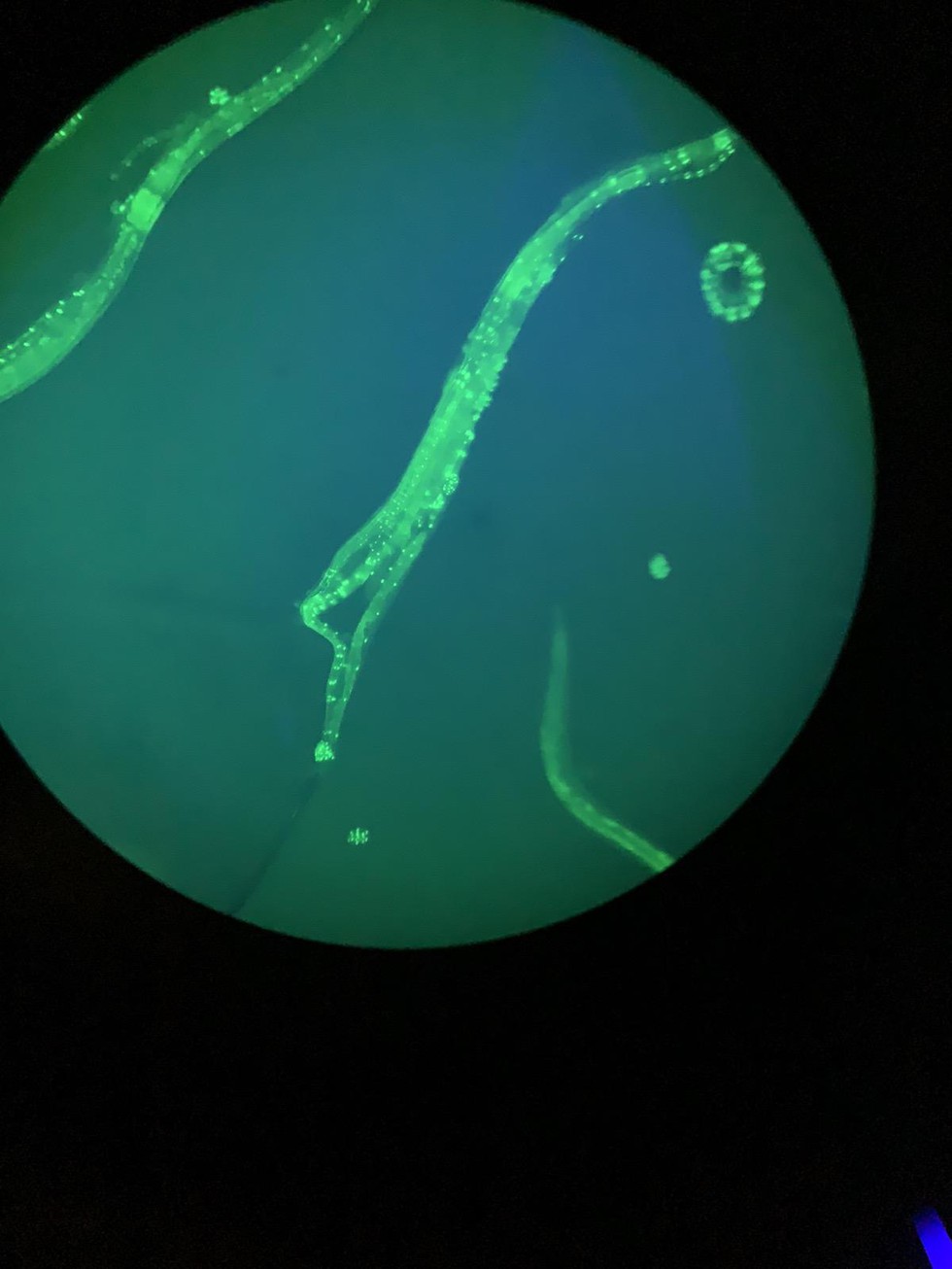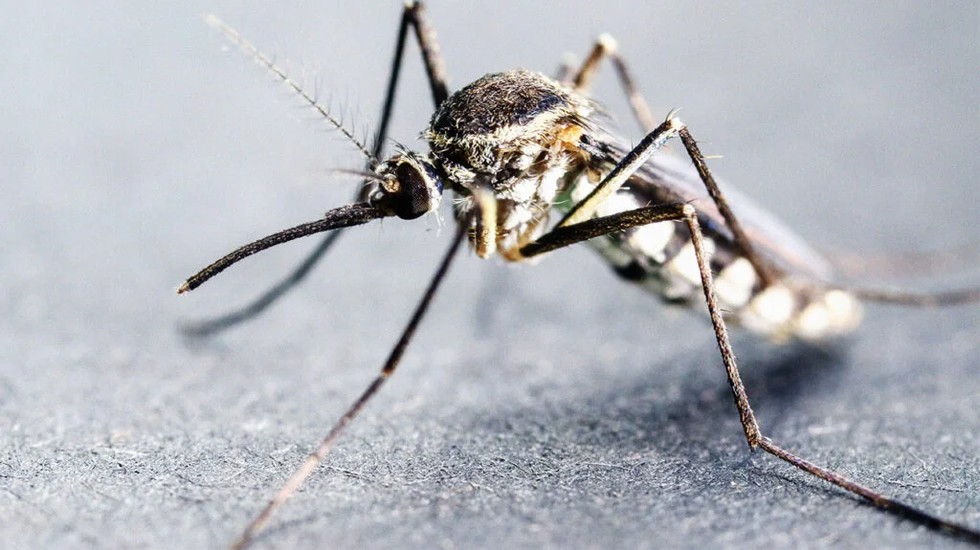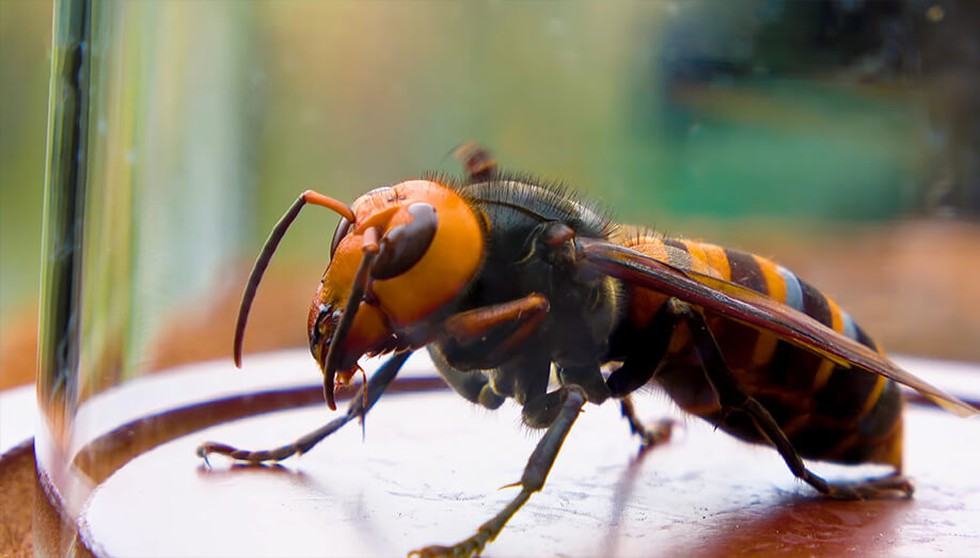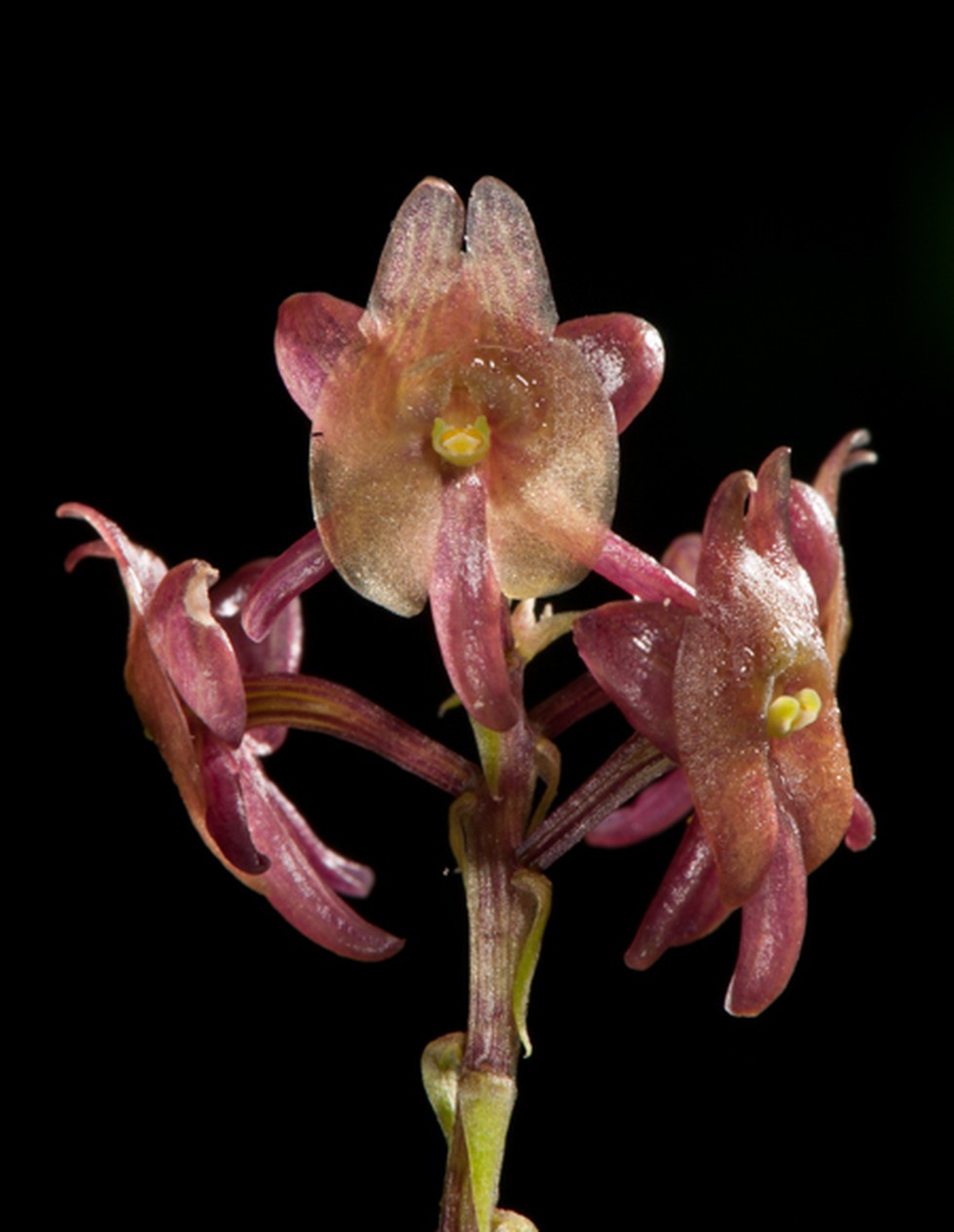
About Nilgiri tit Butterfly:
- It belongs to the family Lycaenidae.
- It was first described in 1884 from Coonoor in the Nilgiris, it has since been recorded in Sri Lanka.
- It was also found in Kalakkad Mundanthurai Tiger Reserve, Chinnar Wildlife Sanctuary of Idukki district, and Silent Valley National Park of Palakkad district in Kerala.
- Appearance
- The male is dark reddish purple-brown on the upper side. It has two black spots capped in orange near the tails. The female is pale brown.
- Habitat: They inhabit forests and lush home gardens, especially those with orchids.
- It was noted to lay its eggs on the inflorescence (complete flower head) of the larval host plant, Eulophia epidendraea, a terrestrial orchid species.
- This is the first known record of the butterfly using this particular species of plant as a host.
- This terrestrial orchid was found on rocky slopes in humid areas.
- This endemic butterfly is classified under Schedule II of the Wildlife Protection Act.
2. Caenorhabditis elegans

About Caenorhabditis elegans:
- It is a nematode wormwhich is a small, relatively simple, and precisely structured organism.
- elegans grows within 3-5 days from a fertilised egg to a millimetre-long adult, and it has informed profound insights into the human body, as well as biology.
- It is widely used in research to understand neuronal and molecular biology.
- It was the first multicellular organism to have its full genome sequenced and neural wiring mapped.
- It has two sexes—a hermaphrodite and a male.
- The hermaphrodite can be viewed most simply as a female that produces a limited number of sperm: she can reproduce either by self-fertilization, using her own sperm, or by cross-fertilization after transfer of male sperm by mating.
- Self-fertilization allows a single heterozygous worm to produce homozygous progeny.
What are Nematodes?
- These are any worm of the phylum Nematoda.
- These are among the most abundant animals on Earth.
- They occur as parasites in animals and plants or as free-living forms in soil, fresh water, marine environments, and even such unusual places as vinegar, beer malts, and water-filled cracks deep within Earth’s crust.
- Features
- Nematodes are bilaterally symmetrical, elongate, and usually tapered at both ends.
- Some species possess a pseudocoel, a fluid-filled body cavity between the digestive tract and the body wall.
3. Malaria

About Malaria:
- It is an acute febrile illness caused by Plasmodium parasites, which are spread to people through the bites of infected female Anopheles mosquitoes.
- It is a life-threatening disease primarily found in tropical countries.
- Transmission
- It is not contagious and cannot spread from one person to another; the disease is transmitted through the bites of female Anopheles mosquitoes.
- Five species of parasites can cause malaria in humans and 2 of these species – Plasmodium falciparum and Plasmodium vivax– pose the greatest threat.
- Symptoms
- The first symptoms of malaria usually begin within 10–15 days after the bite from an infected mosquito.
- Fever, headache and chills are typically experienced, though these symptoms may be mild and difficult to recognize as malaria.
- In malaria endemic areas, people who have developed partial immunity may become infected but experience no symptoms.
- Prevention:
- Vector control interventions: Vector control is the main approach to prevent malaria and reduce transmission.
- Treatment:
- It is preventable and curable.
- Early diagnosis and treatment of malaria reduces disease and prevents deaths, and also contributes to reducing transmission.
4. eShram - One Stop Solution

About eShram - One Stop Solution:
- It will provide seamless access of different Social Security Schemes to the unorganised workers registered on eShram portal.
- Purpose: The primary purpose of the eShram One Stop Solution is to simplify the registration process for unorganised workers and facilitate their access to government welfare schemes.
- This platform will act as a bridge, connecting the workers to the numerous benefits offered by the government and making the registration process easier and more transparent,"
- It entails consolidating and integrating data from various Central Ministries/Departments into a single repository.
- Key welfare schemes such as One Nation One Ration Card, Mahatma Gandhi National Rural Employment Guarantee Act, National Social Assistance Programme, National Career Service, Pradhan Mantri Shram Yogi Maandhan etc. have been integrated with eShram.
-
What is eShram Portal?
- It was launched by the Ministry of Labourand Employment in 2021 for registration and creation of a comprehensive National Database of Unorganized Workers.
- The registration in the portal is fully Aadhaar verified and Aadhaar seeded. Any unorganised worker can register himself or herself on the portal on a self-declaration basis.
- It allows an unorganised worker to register himself or herself on the portal on self-declaration basis, under 400 occupations in 30 broad occupation sectors.
5. Bioluminescence

About Bioluminescence:
- It is a natural phenomenon produced by certain marine organisms, primarily microscopic plankton called dinoflagellates.
- These planktons emit light on the ocean surface at night.
- Bioluminescence is widespread among deep sea animals in general.
- Many marine creatures like sponges, jellyfish, worms, species of fish, arthropods, echinoderms and unicellular alga exhibit bioluminescence to either evade predators, attract prey or during mating.
- This occurs when the luciferase enzyme reacts with luciferincompound in the presence of oxygen to produce a cold light.
- This is widespread in lagoons and sometimes breakwaters and is particularly visible during warm weather conditions.
- The dinoflagellates follow a circadian cycle (24-hour cycle) and as a result this phenomenon occurs during the night which is visible in low light conditions.
- This unique phenomenon has been visible in some other beaches in India including Havelock Island in the Andamans, Thiruvanmiyur beach in Chennai, Mattu beach in Karnataka and Bangaram Island in Lakshadweep.
6. India’s fourth nuclear-powered ballistic missile submarine (SSBN)

About India’s fourth nuclear-powered ballistic missile submarine (SSBN):
- The fourth SSBN is codenamed S4*.
- It boasts nearly 75 percent indigenous content and is equipped with K-4 ballistic missiles, which have a range of 3,500 km and are fired through vertical launching systems.
- While the first of its class, INS Arihant carries 750 km range K-15 nuclear missiles, its successors, INS Arighaat and INS Aridhaman, are all upgrades of the previous ones and carry only K-4 ballistic missiles.
- The launch of S4* follows the commissioning of INS Arighaat in August 2024, and the INS Aridhaman is set for commissioning next year. Both INS Arihant and INS Arighaat are already on deep sea patrols.
- Naming: Since national security planners named India’s first leased nuclear attack submarine INS Chakra as S1, INS Arihant was named S2, INS Arighaat S3, INS Aridhaman S4 and hence the newly launched one is the last of its class, S4* with the formal name yet to be given.
SSBN:
- SSBNs are a potent and highly specialised military asset. Operated by only the United States, Russia, China, the United Kingdom, France, and India, these are armed with submarine-launched nuclear ballistic missiles.
- These submarines are designed to provide a reliable second-strike capability and underpin strategic nuclear deterrence via the principle of mutual assured destruction.
- With unlimited range and endurance, the SSBN is constrained only by food supplies, crew fatigue, and maintenance.
7. What are Hornets?

About Hornets:
- Hornets are a breed of social wasps, living in large, highly organized colonies.
- They are a group of 20 species occurring naturally only in Asia, Europe, and Africa, with one species introduced to North America.
- Hornets belong to the insect family Vespidae. This family contains each species of hornets as well as wasps such as yellow jackets, paper wasps, potter wasps, and pollen wasps.
- Hornets tend to be black or brown with yellow or yellowish markings.
- Due to their size, hornets have a reputation for being more dangerous than other wasp species, though they are not always more aggressive.
- Hornets release more venom per sting than any other stinging insect.
- One species, the northern giant hornet, or Asian giant hornet (V. mandarinia), which is native to Asia, is the largest known wasp species in the world.
- Typically, hornets like to build their nests in high areas.
- Diet:
- Hornets are known to have a rich diet of sugar and protein, among other things.
- They prey on other insects, including honeybees and social wasps, and chew them into a paste as food for their larvae.
8. What is the Nature Restoration Law (NRL)?

About Nature Restoration Law (NRL):
- It is a European Union (EU) law to tackle the triple crises of climate change, biodiversity loss, and environmental degradation.
- It is the first continent-wide, comprehensive law of its kind.
- It is a key element of the EU Biodiversity Strategy, which sets binding targets to restore degraded ecosystems, in particular those with the most potential to capture and store carbon and to prevent and reduce the impact of natural disasters.
- Under the NRL, Member States will have to restore at least 20% of the EU’s land and sea by 2030, including terrestrial, coastal, and freshwater, forest, agricultural, and urban areas.
- By 2050, the measures should extend to all ecosystems "requiring restoration".
- The EU NRL also targets an obligation to improve urban green spaces, contribute to free-flowing rivers by removing artificial barriers, increase pollinator populations, and contribute to the target of 3 billion additional trees throughout the EU.
- Member States must adopt "restoration plans" detailing how they intend to achieve these targets and ensure that the restored areas do not significantly deteriorate.
- While drafting these Nature Restoration Plans, Member States also need to consider socio-economic impacts and benefits and estimate the financial needs for its implementation.
9. What is the International Atomic Energy Agency (IAEA)?

About International Atomic Energy Agency (IAEA):
- It is the world's foremost intergovernmental forum for scientific and technical cooperation in the nuclear field.
- It is widely known as the world's "Atoms for Peace and Development" organizationwithin the United Nations family.
- It works for the safe, secure, and peaceful uses of nuclear scienceand technology.
- History: Though established as an autonomous organisation, independently of the United Nations through its own international treaty,the IAEA Statute, the IAEA reports to both the United Nations General Assembly and Security Council.
- Headquarters: Vienna,Austria.
- Currently, it has 178 member states.
- Structure:
- The General Conference, consisting of all members, meets annually to approve the budget and programs and to debate the IAEA’s general policies.
- The Board of Governors, which consists of 35 members who meet about five times per year, is charged with carrying out the agency’s statutory functions, approving safeguards agreements, and appointing the director general.
- The day-to-day affairs of the IAEA are run by the Secretariat, which is headed by the director general.
- Functions of IAEA:
- The Agency works with its Member States and multiple partners worldwide to promote the safe, secure and peaceful use of nuclear technologies.
- It applies nuclear safeguards– consisting of monitoring, inspection, information analysis, and other activities – to verify that nuclear activities remain peaceful and detect and deter their diversion, including to weapons-related purposes.
- In particular, the IAEA implements comprehensive safeguards agreements mandated by the Nuclear Non-Proliferation Treaty (NPT), which serve as a first line of defense against nuclear weapons proliferation.
- IAEA assists its Member States and promotes the exchange of scientific and technical informationbetween them.
- IAEA enhances national, regional, and international capacities to respond to nuclear and radiological incidents, which is essential to minimizing their impact.
10. What is Crepidium assamicum?

About Crepidium assamicum:
- It is a new species of orchid under the genus Crepidium.
- It was discovered in Dibru Saikhowa National Park, Assam.
- It was discovered by assistant professors of the Department of Botany, Guwahati College, Dr. Jintu Sarma and Khyanjeet Gogoi, popularly known as the Orchid Man of Assam.
- With this, the total species of Crepidium in India has increased to 19, and globally, the number touched the mark of 281.
- Scientific reports verify that there are about 27,000 species of diverse orchids in the world, with India hosting about 1,265 of them and Northeast India about 800. Assam harbors about 414 species of orchids.
Key Facts about Dibru Saikhowa National Park:
- It is a national park as well as a biosphere reserve located in Dibrugarh and Tinsukia districts, Assam.
- It is bound by the Brahmaputra and Lohit Rivers in the north and the Dibru River in the south.
- Vegetation: The forest type of Dibru-Saikhowa comprises semi-evergreen forests, deciduous forests, littoral and swamp forests, and patches of wet evergreen
- It is the largest salix swamp forest in northeastern India.
- Climate: It has a tropical monsoon climate with a hot and wet summer and cool and usually dry winter.
- Flora: Some of the dominant flora found are Dillenia indica, Bischofia javanica, Bombax ceiba, Lagerstroemia parviflora, etc.
- Fauna: Tiger, Elephant, Leopard, Jungle Cat, Bears, Small Indian Civet, Squirrels, Gangetic Dolphin, Hoolock Gibbon, Feral Horses,etc.


























































































































































.png)
.png)
.png)
.png)
.png)


.png)
.png)
.png)





.png)
.png)






.png)
.png)
.png)
.png)
.png)
.png)
.png)
.png)
.png)

.png)







.png)
.png)


.png)
.png)
.png)


.png)

.png)
.png)





.jpg)

.png)
.png)


.png)

.png)
.png)
.png)

.jpg)

.jpg)


.png)

.png)
.png)
.png)
.png)
.png)
.png)
.png)
.png)
.png)
.png)




.png)

.png)





.png)
.png)
.png)
.png)
.png)
.png)
.png)
.png)
.png)
.png)
.jpg)
.jpg)

.png)
.png)
.png)
.png)
.png)
.png)
.png)
.png)
.png)
.png)
.png)
.png)
.png)
.png)
.png)
.png)
.png)
.png)
.png)
.png)
.png)
.png)



.png)
.png)

.jpg)
.jpg)


.jpg)
.jpg)
.jpg)
.jpg)
.jpg)

.jpg)








.jpg)
.jpg)
.jpg)
.jpg)
.jpg)

















.jpg)
.jpg)







.jpg)


















.jpg)
.jpg)






























































































.jpg)
.jpg)


























.jpg)

.jpg)










.jpg)








.jpg)




.jpg)










.jpg)


















.jpg)












































.jpg)














.jpg)
.jpg)
.jpg)





.jpg)

.jpg)
.jpg)





































































.jpg)


































.jpg)
.jpg)
















































.jpg)












.jpg)


.jpg)




.jpg)
.jpg)
.jpg)

.jpg)
.jpg)
.jpg)
.jpg)

.jpg)
.jpg)
.jpg)

.jpg)
.jpg)
.jpg)
.jpg)
.jpg)
.jpg)
.jpg)
.jpg)

.jpg)


.jpg)
.jpg)
.jpg)
.jpg)
.jpg)
.jpg)
.jpg)
.jpg)
.jpg)
.jpg)











.jpg)
.jpg)





.jpg)
.jpg)
.jpg)
























.jpg)
























.jpg)









.jpg)
.jpg)







.jpg)
.jpg)









































.jpg)
.jpg)
.jpg)
.jpg)
.jpg)

.jpg)
.jpg)
.jpg)
.jpg)
.jpg)


.jpg)
.jpg)
.jpg)
.jpg)
.jpg)

.jpg)
.jpg)
.jpg)
.jpg)
.jpg)
.jpg)
.jpg)
.jpg)
.jpg)
.jpg)
.png)

.png)
.png)

.png)
.png)
.png)
.png)


.jpg)
.jpg)

.jpg)
.jpg)
.jpg)

.png)
.png)
.png)
.png)
.png)
.png)
.png)

.png)
.png)
.png)
.png)
.png)
.png)
.png)
.png)
.png)
.png)





































































-min.png)



.png)




.png)








































